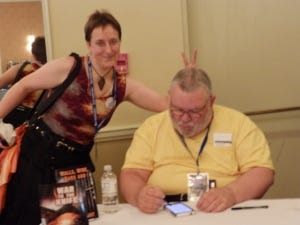Anatomy of a Book Cover

Dorothy and Peter Grant at LibertyCon 27
Dorothy Grant published a short series of articles on her blog that I would like to draw your attention to. She's the brilliant, quieter half, of the man responsible for one of the best new series of Space Operas coming out right now, Peter Grant. I've reviewed his work a few times, and will keep doing it. But if you ever wonder how his books look so attractive, look just over his shoulder to see Dorothy.
She opens her series with Cover Art Composition and Layout, covering some of the basics you see on an unconcious level that make a cover pull together and work well. "2. Make your name bigger because trad pub has trained readers that big names are important, awesome authors that should be bestsellers, while small names are forgettable midlist. You want to be a bestseller someday - start faking it til you make it, because the reader won't believe it if you don't design your cover like it." Yep, MAKE YOUR NAME BIGGER is usually the first thing I say to an Indie Author.
Typography & Cover Art is about more elements that you process unconciously, and which are part of a reader's first impression of your book. "Don't judge a book by it's cover" is not a rule, it's an admonition to try to get better behavior right up there with "Don't eat those cookies now, you'll ruin your dinner." Readers, browsers, customers, reviewers, and probably the cat all judge a book by its cover. (Okay, the last one's criteria is 'best spot to sleep.')"
But I'm Not an Artist! Dorothy talks about what to do if you can't draw, yourself. I have said on this blog before that using stock art is just fine, withing reason. She also points out that you can hire someone (like me! you can contact me at cedarlila at gmail dot com). "If you want great covers, and your drawing ability is still stuck at little stick men, do not despair. You don't have to be a good artist to get great covers. Go back and read up on design, typography, layout, and art not with the despairing expectation that you'll be called upon to create your own cover, but with the confidence that you'll now know just enough to be able to tell the cover artist / designer you hire why you like their design, or why not, and what you want changed. If you can speak the same technical language as them, or even get fairly close pidgin, you'll be able to collaborate for a far better cover than "Um, I don't like it because it doesn't feel right. I dunno, the thingie is just not good, so change it."
Finally, she gets into the nitty-gritty of writing a blurb. I will reveal here that Dorothy wrote the blurb I use on the back of Vulcan's Kittens. I didn't ask her for it, she did it out of the kindness of her heart when she saw whatever atrocity I had used. Thanks, Dorothy! That's not why I tuckerized her in Pixie and Trickster, but because she's a nifty person all around. "I know, I know. If you could say everything interesting about your novel, it'd be as long as... your novel. Welcome to the wonderful world of ad copy, also called promotional copy, and generally referred to as "the blurb." (Which is a misused term, as "blurb" used to mean solely the line on thefront cover by famous author saying "greatest thing since hot running water!" But misused or not, it's becoming the standard term. I still think "blog" is a silly term, but just stand aside while the relentless changes to the english language roll on...) First, just as the book cover is an advertisement not a true representation of your book, the blurb is an advertisement, not a plot summary. If you are describing what's going on past chapter 3, you're doing it wrong."
I'm hoping there will be more, so keep an eye out. If you'd like to follow along with some really fascinating articles on history, politics, economics, and many more topics, you can find Peter Grant's blog here, Bayou Renaissance Man.
Edited to add: She has put up more articles since I prepared this post, one on Master Classes on Writing, which has links to many places I've mentioned, but are worth bookmarking and delving into. The other is on the esoteric but vital art of keywords and categories.



